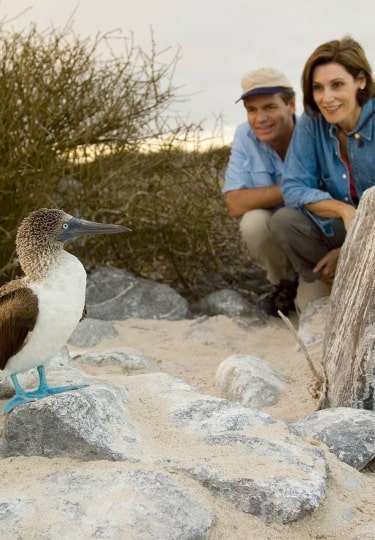Spotting and observing Galapagos birds is a fascinating activity since the archipelago’s remote location allows you to get close to many species which have no fear of humans. You’ll get to understand the habits and rituals of the islands’ birds like nowhere else and will enjoy unprecedented chances to watch courtship dances, aerial battles, hunting techniques, and even newly fledged juveniles attempting their first flight.
There are plenty of birds to spot, too. The islands have 56 native species, 45 of which are endemic (or in other words, found only in the Galapagos), and 11 indigenous ones, which means that they’re found here but also elsewhere, for example, blue-footed boobies, pelicans, and frigatebirds.
In learning about the distribution of Galapagos birds, some of which you’ll find only on certain islands, you’ll also begin to understand the dawning of Charles Darwin’s groundbreaking theory of evolution by natural selection, which he developed during his visit to the Galapagos in 1835 after studying the finches and mockingbirds.
Here are 12 species of Galapagos birds you’ll want to look out for during your travels in the area.
Galapagos Penguin
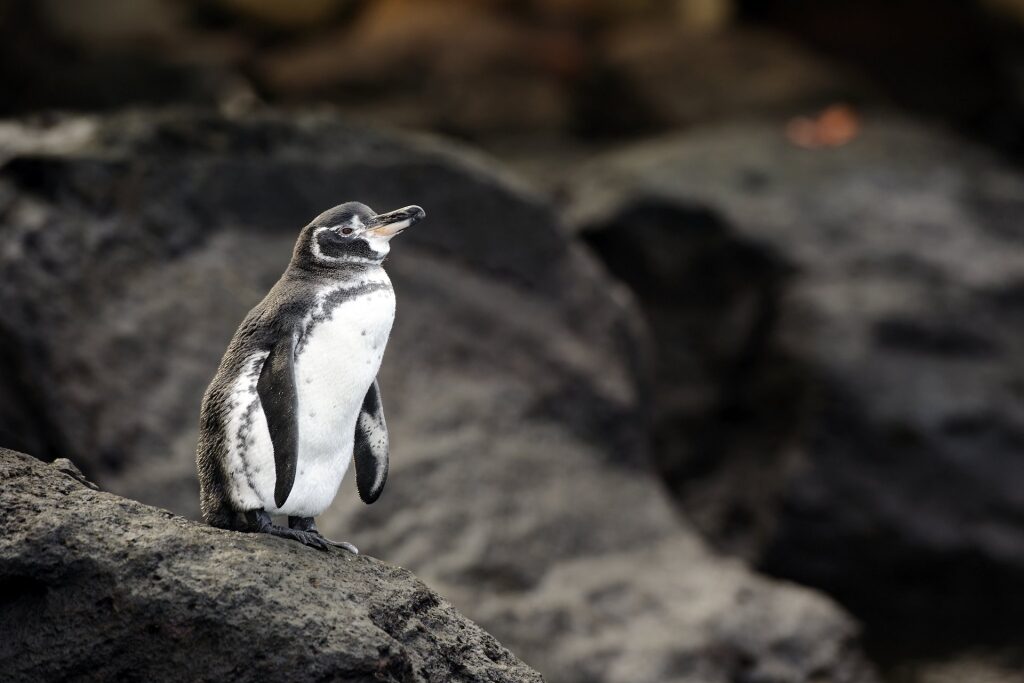
Galapagos penguin
Where else in the world could you spot a penguin standing next to a cactus on lava rocks? The Galapagos penguin is the only member of the penguin family to live on the equator. You’ll most likely spot them on Fernandina and Isabela islands, where the waters are rich with the nutrients on which they feed.
The black-and-white Galapagos penguins are both cute and curious; having a few pop up next to you while you’re snorkeling is a memorable experience. Stay around and watch them dive—they zoom around like bullets under the water. The penguins are in the islands all year round, so you’ll have a good chance of seeing a couple during your visit.
Flightless Cormorant
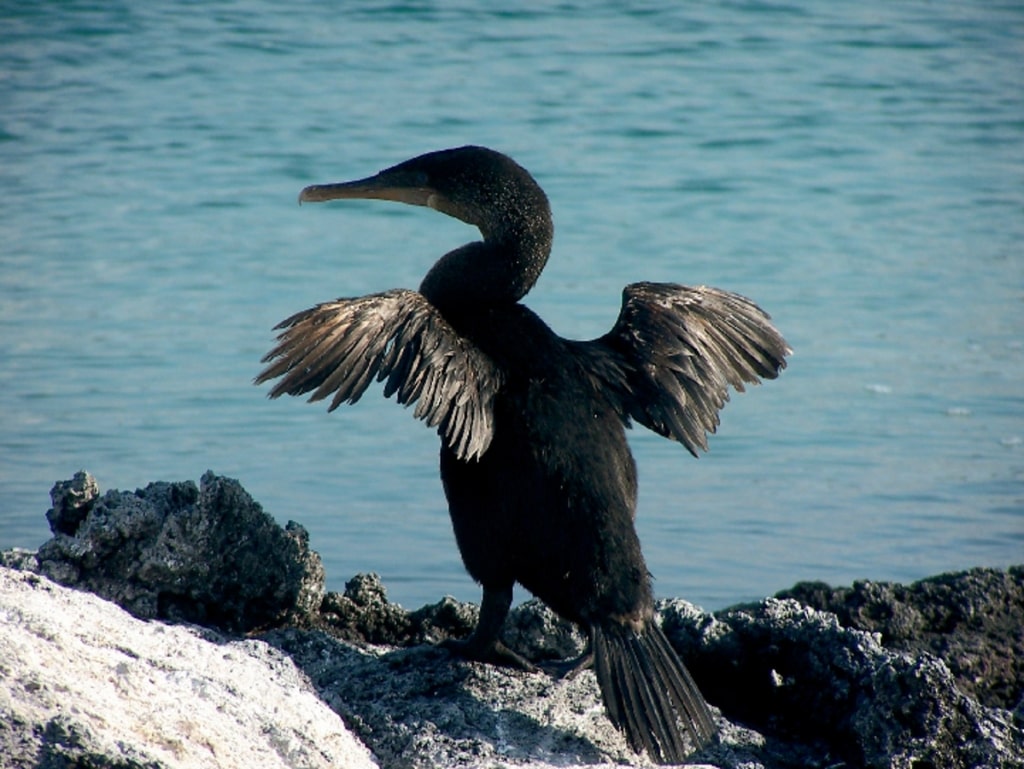
Flightless cormorant
Also at home on the western islands of Fernandina and Isabela is the flightless cormorant. Unlike its distant relatives elsewhere in the world, this Galapagos bird has lost its ability to fly; swimming is a more useful and efficient way for it to feed. You’ll recognize this bird by its little stubby wings, used only for balance, and strong legs. You’ll often spot it diving for eels, small octopus, and fish.
As with other cormorants, the feathers of the Galapagos cormorant aren’t waterproof so you’ll sometimes see the birds standing on the rocks with their wings spread out in the sun to dry after each dive. Cormorants aren’t migratory, meaning you’ll spot them year-round. They tend to their chicks between July and October when the weather is cooler.
Waved Albatross
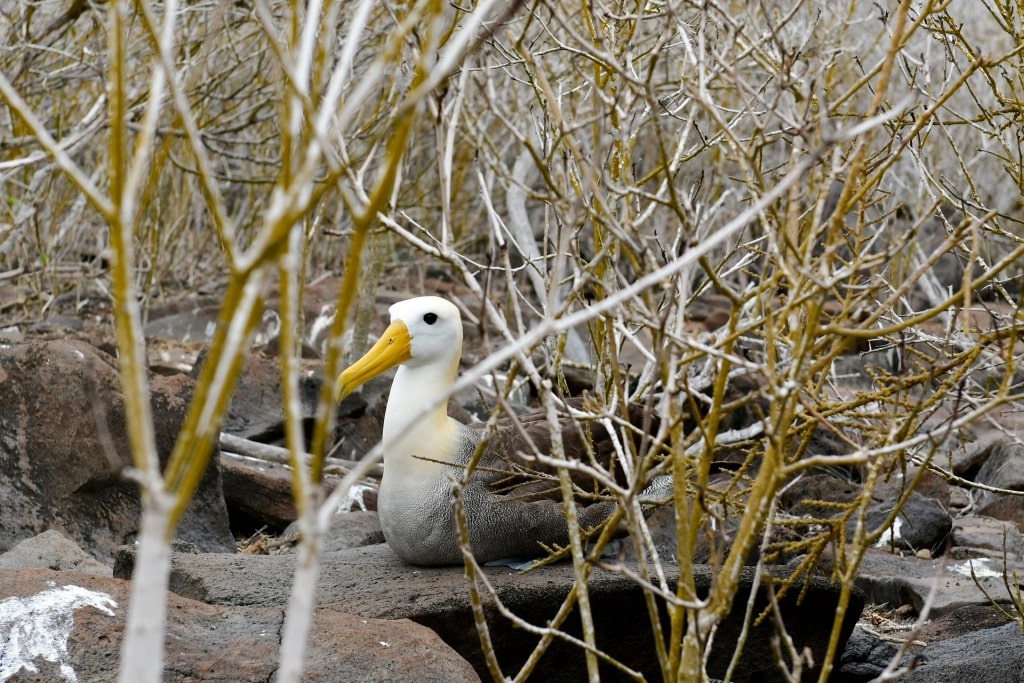
Waved albatross
The graceful waved albatross arrives at Española Island in late March, laying eggs between mid-April and late June. It’s the largest of all the Galapagos islands birds with a wingspan of an impressive eight feet, which gives it the ability to glide low over the crests of the waves, spending much of its life over the open ocean.
The waved albatross mates for life after selecting a partner with a seemingly bizarre courtship dance that involves head bobbing, circling of the long, yellow beak, clashing beaks together as if in a sword fight, as well as honking and waddling. The egg is laid on the ground—there’s no such thing as a nest for this bird—chicks are raised in nursery groups so the parents can go off to feed. Once they’ve fledged, the young albatross will spend six years at sea before returning to the same spot to find a mate.
If you want to see the waved albatross, avoid going to the Galapagos from January to March, when they’re out at sea. Also make sure to pick an itinerary that includes Española, as this is the only island where they’re found. And spare a thought for this beautiful albatross as sadly, it’s critically endangered. Outside the safety of the pristine Galapagos Marine Reserve, it has no protection.
Galapagos Hawk
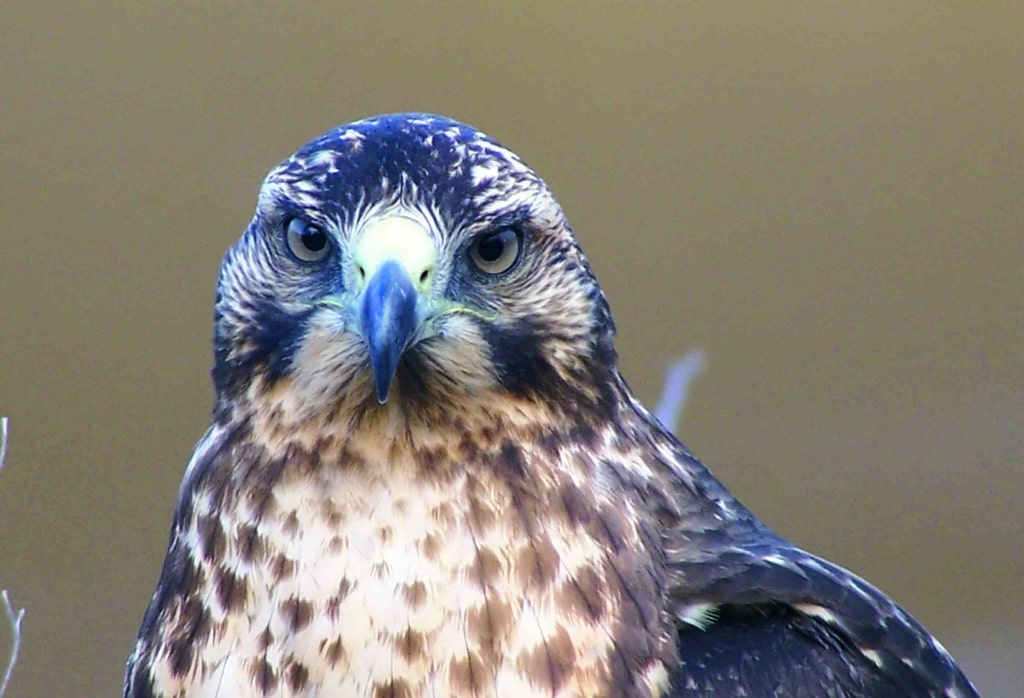
Galapagos hawk
The rare Galapagos hawk, the largest land bird of the Galapagos, is mostly seen on the main islands of Isabela and Fernandina. The Galapagos Conservation Trust believes there are only about 150 breeding pairs left. The adults are dark brown and the juveniles paler, with creamy plumage that acts as camouflage to protect them from predators. Chicks are tended by males, while the larger females hunt for food.
Galapagos hawks are the islands’ only birds of prey. They feed on giant centipedes, locusts, small reptiles, including baby iguanas and sea turtles, and also scavenge, using their razor-sharp, hooked beaks. If you’re lucky enough to spot a nest, often found low in the trees or on the ground, steer clear as the slightest disturbance can cause the birds to abandon their young.
Darwin’s Finches
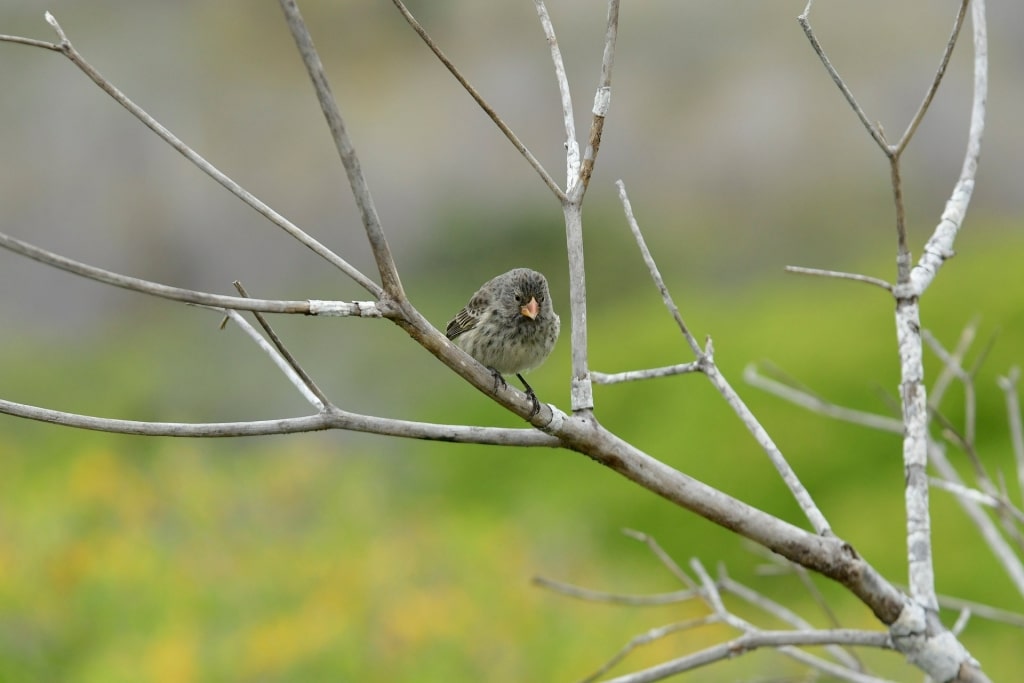
Darwin’s finches
These unassuming little sparrow-sized birds played a pivotal role in the development of Charles Darwin’s theory of evolution by natural selection. There are thirteen different species of finches that are endemic to the Galapagos.
When Darwin visited the Galapagos in 1835, he studied the beaks of the finches and found that they were slightly different on each island. He concluded that the birds had evolved, and their beak shapes had adapted over time to catch the different food available on each island, be it seeds or insects. The strongest and most successful finches passed on their genes, which led to a gradual change in the birds on each island.
You’ll spot finches everywhere, but some are specific to certain habitats or islands. The large and the common cactus finches feed on the prickly pear cacti found throughout the islands, while the much rarer woodpecker finch uses tools like sticks or cactus spikes to root out insects in trees.
The sharp-beaked ground finch mostly feeds on seeds, except for those that live on the remote islands of Wolf and Darwin, which drink the blood of bigger birds, mainly boobies, earning themselves the nickname of “vampire finch.”
Española Mockingbird
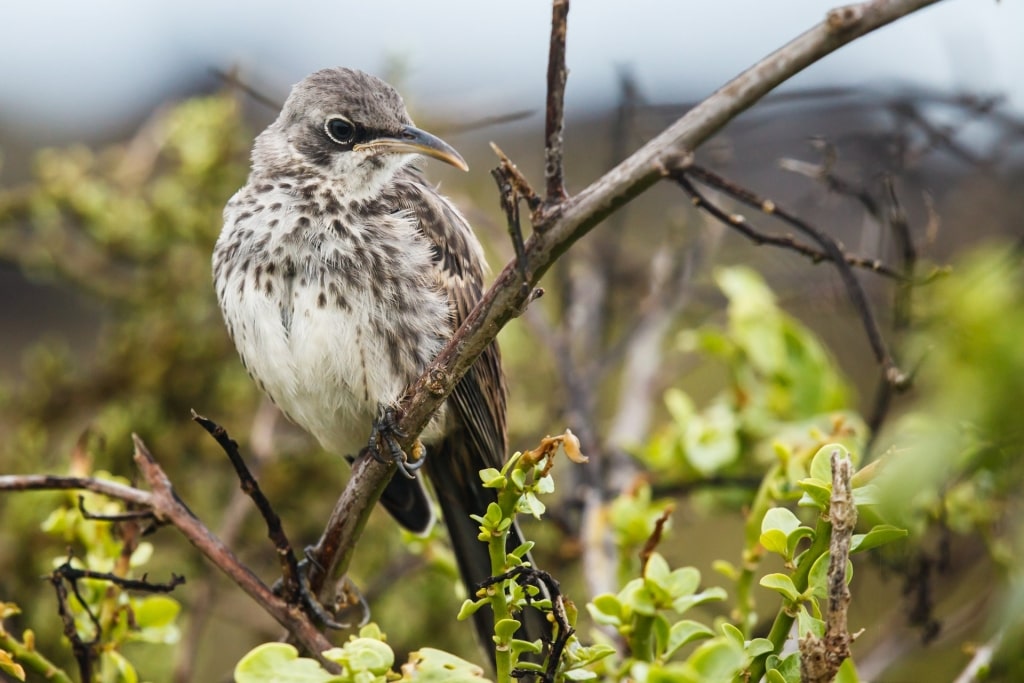
Española mockingbird
This cheeky mockingbird, found only on the island of Española, is identified by its grey and white plumage, long tail, and curved bill. But you’ll more than likely identify it as the bird that’s hitching a ride on your day pack or pecking at your shoelaces during your trip.
Mockingbirds have no fear of humans and will often pester hikers for water by pecking at exposed water bottles. They’re omnivorous feeders, eating insects, crabs, lizards, fruit, and even ticks feeding on iguanas. Mockingbirds have also been spotted cracking eggs of other birds and drinking the blood of injured sea lions.
Like the finches, mockingbirds played a role in Darwin’s theory of natural selection, since the Floreana mockingbird, which is found only on tiny Gardner and Champion islands, is quite different in appearance from its Española cousin.
Unlike their namesakes in other parts of the world, mockingbirds in the Galapagos don’t imitate other species. They do, however, have different calls for different situations and naturalists have observed that in unlikely cooperation between species, marine iguanas have learned to recognize the mockingbird’s alarm call, possibly because the two share the same predators, like the Galapagos hawk.
Galapagos Flycatcher
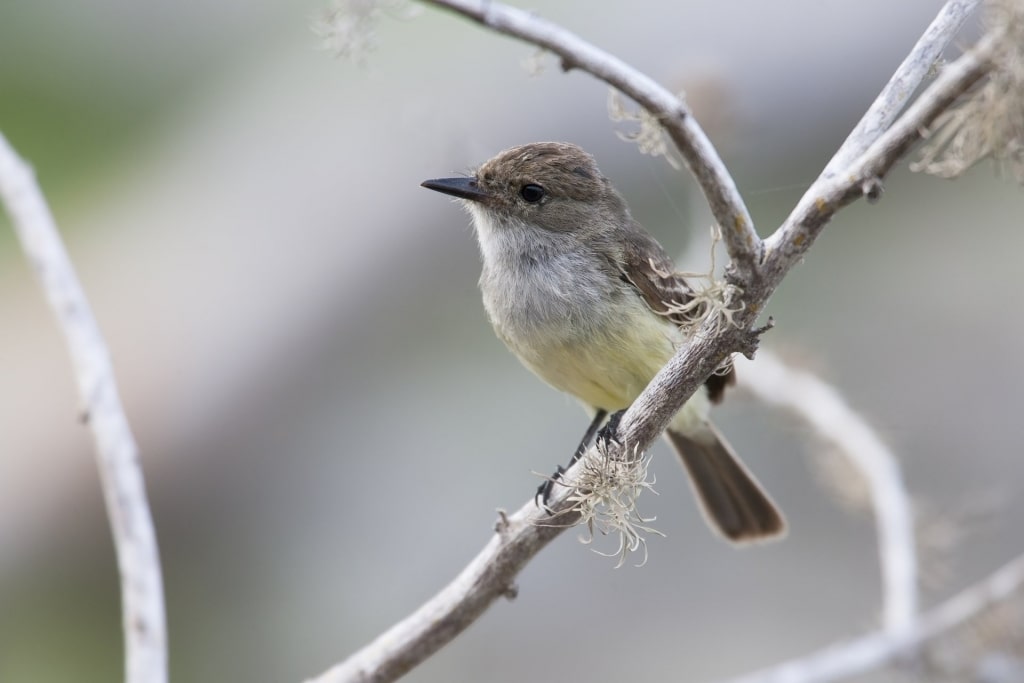
Galapagos flycatcher
The Galapagos flycatcher, or long-billed flycatcher, or papamoscas, as it is known by Galapagos islanders, is identified by its brown plumage and yellow belly. Both males and females have startling crests—scarlet, black, and blue in the case of the male—but you’ll rarely see them on display.
Flycatchers are found throughout the islands, mainly in the arid lowlands. Like mockingbirds, they’re both curious and fearless and won’t hesitate to perch on your backpack or even your head. They’re attracted to cameras, too, drawn to their reflections, and may well fly at photographers, or perch themselves on long lenses.
Galapagos Petrel
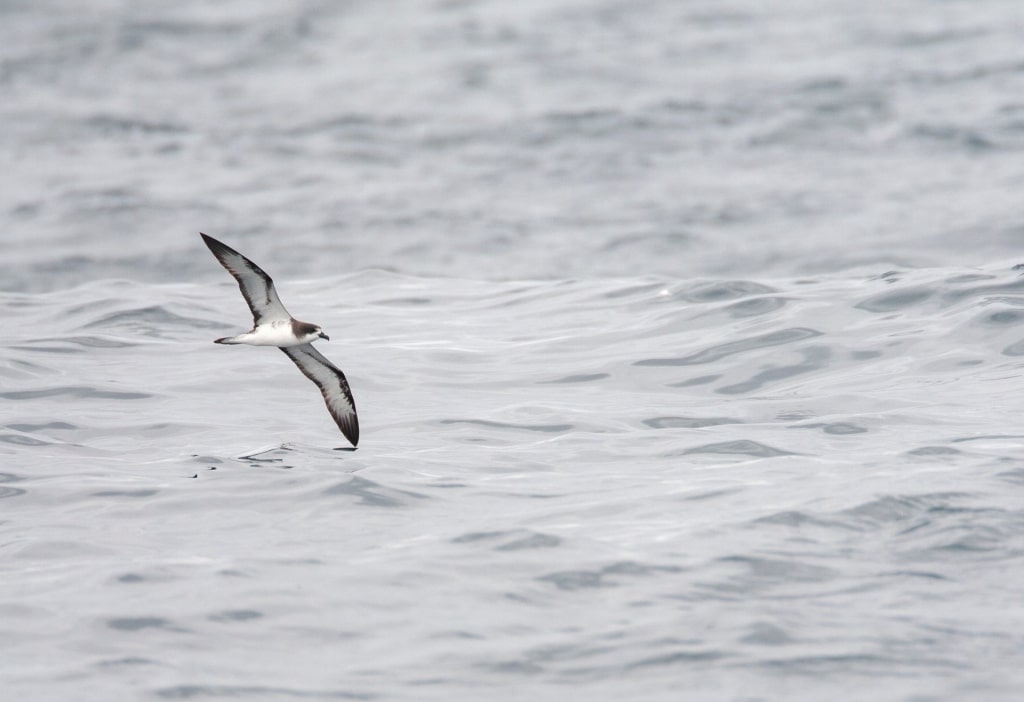
Galapagos petrel
Although the Galapagos petrel is endemic to the islands, its range is enormous and individuals have been spotted as far away as Central America and the northern reaches of South America. Petrels are built for long-distance flight with long wings that allow them to glide as they hunt for squid, fish, and crustaceans. You’ll identify them by their white underparts, wings outlined with black, and their white foreheads.
You’re most likely to spot Galapagos petrels on higher ground, on the islands to the north and east of the archipelago, including Floreana, Santiago, Santa Cruz, San Cristobal, and Isabela. They breed between April and October, nesting in burrows or rocky hollows, but outside these months, they tend to spend all of their time feeding at sea.
Sadly, Galapagos petrels are listed as a critically endangered species, mainly because of the destruction of their habitat by invasive species like rats and marine plastic pollution. However, conservation efforts in the islands have helped to raise the population to around 8,500 pairs.
Lava Gull
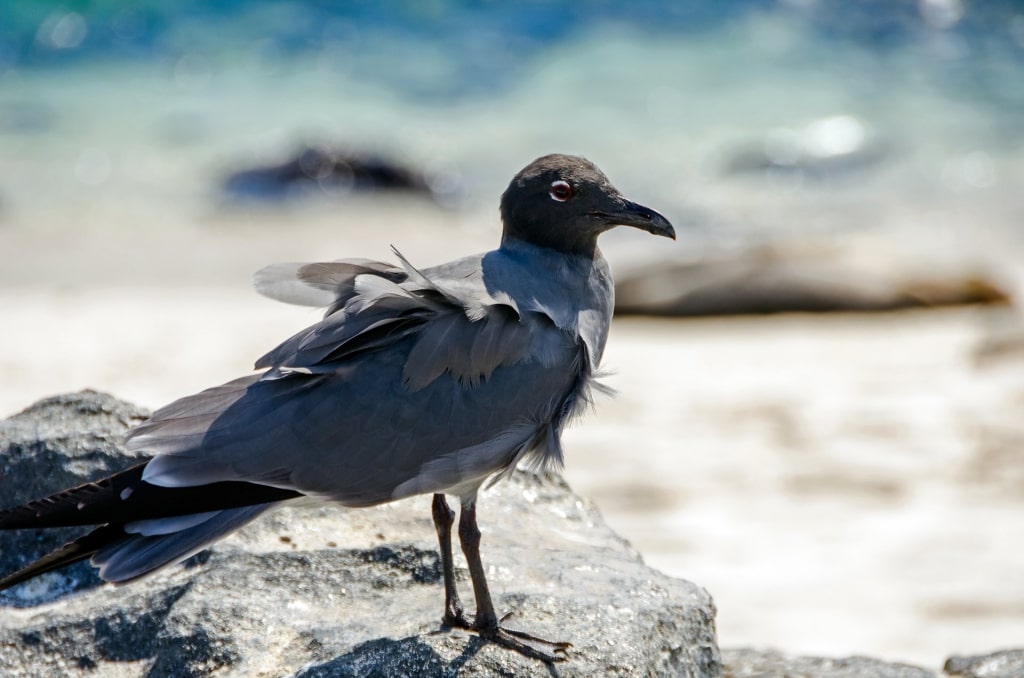
Lava gull
With a population of just a few hundred individuals, these handsome birds are thought to be one of the rarest gulls in the world. If you’re lucky, you could see them on four islands: Santa Cruz, Genovesa, Isabela, and San Cristobal.
Sometimes they’re flying over fishing boats or picking off newly hatched iguanas and baby turtles. Lava gulls are easily identified thanks to their sooty grey or black head, dark grey wings, and pure white line around the eye.
They nest on the ground, hidden by the coastal vegetation, and rather than forming colonies, they tend to keep to themselves, defending their territory aggressively from other birds.
Swallow-tailed Gull
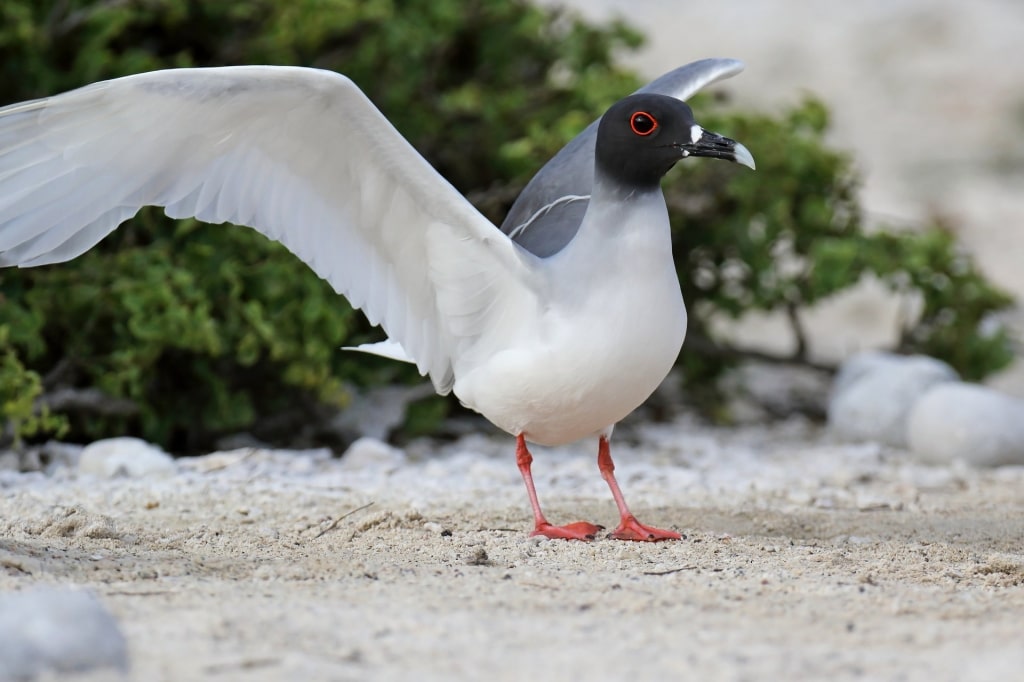
Swallow-tailed gull
The swallow-tailed gull is the only nocturnal gull in the world. It is equipped with super-sensitive night vision that allows it to prey on squid and small fish that rise to the surface of the ocean at night to feed on plankton. The adult bird is easily identified by its sooty-colored head and big, black eyes ringed with scarlet. Their white tail, as the bird’s name suggests, also has a distinctive V shape in flight.
You’ll see swallow-tailed gulls on all of the islands, although most likely on Genovesa and South Plaza, where they nest on cliffs or under camouflaged vegetation on stony Galapagos beaches. When they’re not nesting, swallow-tailed gulls are at sea, covering a range of hundreds of miles in search of food.
Galapagos Dove
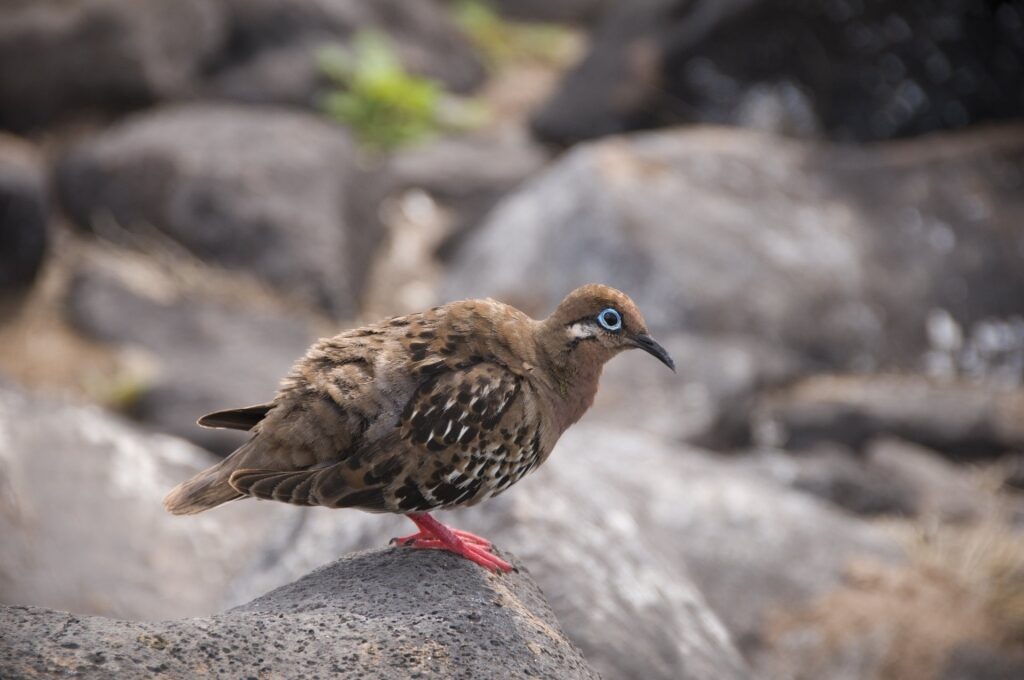
Galapagos dove
Unlike most people’s vision of a conventional dove, the Galapagos dove is a brown bird with a reddish breast, black and white wings, bright red legs, and a striking cobalt-blue ring around its eyes.
You’ll see Galapagos doves around prickly pear cacti, feeding on the fruits and digging vigorously for buried seeds, often displacing large amounts of soil. Interestingly, on some islands, notably Genovesa, the cactus itself has evolved with softer spines, allowing the doves easier access to the flowers, which they pollinate in the absence of bees.
Due to their friendly, inquisitive nature, and their rather self-destructive reluctance to fly, Galapagos doves fell prey to the early explorers that visited the islands.
Sailors that landed here in the 17th century would easily capture the birds along with tortoises and transported the creatures in the holds of their ships for food. Over time, the doves have learned to be warier of humans, but are nonetheless pretty easy to spot throughout the year on most islands.
Blue-footed Booby
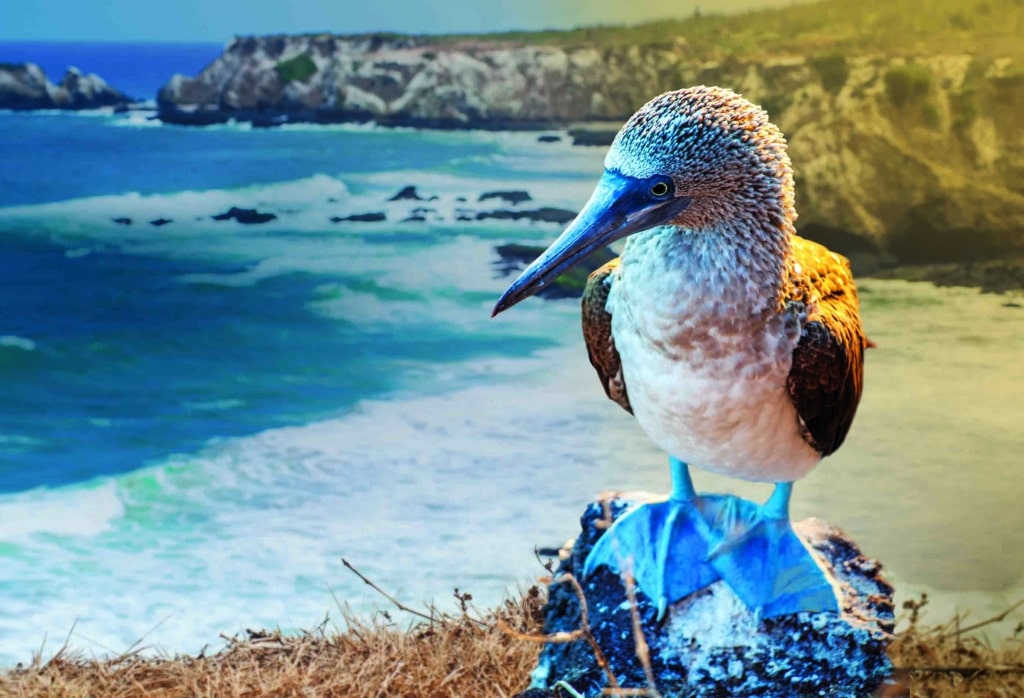
Blue-footed booby
While it’s not endemic to the islands, the blue-footed booby is probably the most iconic of the archipelago’s birds, and spotting it is one of the best things to do in the Galapagos Islands. Its feet are a startling shade of blue, and for a male, the bluer the better, as a vibrant hue is considered a sign of virility. Boobies show off their feet in an elaborate courtship dance that involves the male strutting around the female in a high-stepping gait after presenting her with the gift of a stick or a pebble.
The gannet-like booby is an efficient fishing machine. It streamlines its body by folding back its wings and diving from up to 80 feet, hitting the water at 60 mph and trapping anchovies and sardines in its long, serrated bill on the ascent from the dive.
You’ll spot them all over the islands, although North Seymour has the biggest colony. June to August is the nesting season when chicks are raised in a scrape in the ground, but you should be able to snap a great photo of this curious-looking bird at any time of year.
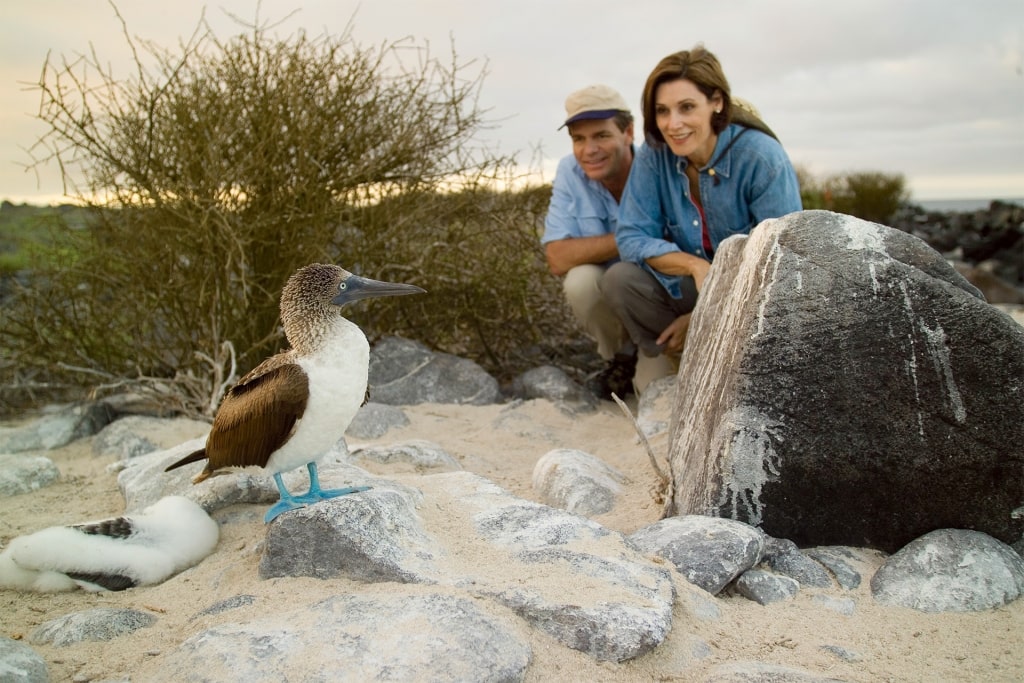
Blue-footed booby
Inspired to seek out these remarkable Galapagos birds for yourself? A cruise to the Galapagos with Celebrity Cruises is the best way to experience this incredible place. Browse our range of thrilling itineraries on our website.
